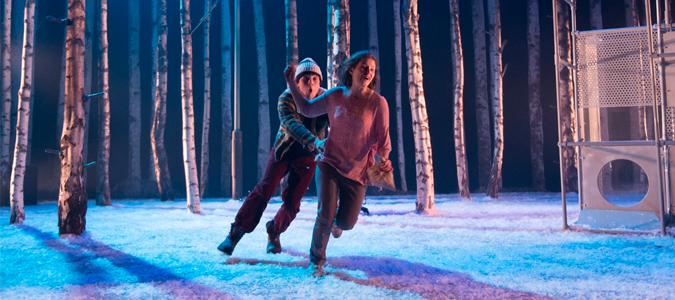

Let the Right One In (London)
Opening Night: March 26, 2014
Closing: August 30, 2014
Theater: Apollo Theatre London
Oskar is a lonely boy from a broken home. He’s bullied at school and is longing for friendship. Eli is a troubled girl who’s just moved in next door. She never goes to school and is compelled to fill an eternal emptiness. When a series of brutal killings plagues the neighbourhood, these two young misfits make a deep connection, sensing in each other a kindred spirit. But the shocking truth about Eli tests Oskar’s loyalty – and love – beyond all imaginable limits, in this chilling tale of loneliness, love and legend.
BUY TICKETSREAD THE REVIEWS:
April 11, 2014
What began as a novel and was subsequently resurrected on celluloid in two film versions – the original Swedish and a remarkably good American remake – Let The Right One In is one of the most successful variants on the hackneyed myth of vampires in the past two decades. If this latest incarnation loses much in the transition it is still a potent chiller. Jack Thorne’s adaptation for the National Theatre of Scotland transfers the action from a soulless Stockholm suburb to an anonymous Scottish one. As bullied schoolboy Oskar (Martin Quinn) pursues revenge fantasies at night by stabbing a knife into the trees, he is observed by his new neighbour Eli (Rebecca Benson) from a climbing frame. Although both are caught in the maelstrom of puberty Eli has the self-possession of someone, or something, older. Inexplicably Thorne fails to include Eli’s most telling line from John Ajvide Lindqvist’s screenplay – “I’m 12. “But I’ve been 12 for a long time.”
READ THE REVIEWJune 11, 2014
At odds with its basking height-of- summer premiere, the National Theatre of Scotland’s stage adaptation of John Ajvide Lindqvist’s cult supernatural coming-of-age novel – later adapted for the cinema in its native Sweden and the US – brings the eerie chill of a northern winter wilderness into the theatre. John Tiffany, the award-winning director of Once and Black Watch and the NTS’s outgoing associate director, has created a taut physical hymn to isolation and otherness that feasts on the cold distance between people in isolated communities. Even as the audience take their seats, the nine-strong cast flit across the stage one by one, slowly at first, and then falling through the towering silver birch trees of Christine Jones’s wonderfully sparse set, glancing behind them for sight of an unseen menace in the dark. As in his previous collaborations with Tiffany, associate director Steven Hoggett’s choreography is understated yet hypnotic, a defining feature of the play’s strong visual identity.
READ THE REVIEWApril 8, 2014
The Apollo Theatre has risen from the grave after last year’s ceiling collapse, and under the moonlit temporary canopy of its ceiling, the National Theatre of Scotland’s elegant, frostbitten take on modern vampire classic this has been resurrected to brilliant effect. Jack Thorne’s script for Let the Right One In is an unfussy take on the novel by John Ajvide Lindqvist, more successful than either of the film versions, locating the action in a frozen middle-ground between Sweden and Dundee. The cast speak in Scottish accents but the props and the layout of the isolated woodland town seem distinctly Scandinavian. Thorne brings young Oskar’s social awkwardness to the fore, linking him to an unknowing continuity of remote and angry young men who find themselves ignored by their parents and scorned by their peers. One of several brilliant dance-like interludes in John Tiffany’s gorgeous production sees Oskar practising thrusts and swipes with a stolen knife as the woods behind him fill with other boys rehearsing the same feeble retributions.
READ THE REVIEWJune 9, 2014
Butterfly or moth? Swan or duck? Angel or vampire? The teenagers at the chilling heart of John Ajvide Lindqvist’s novel and its two film adaptations could go either way. They are at that formative point in adolescence, before their first kiss, when they are ripe with potential and burdened with uncertainty. The mysterious Eli, both youthful and ageless, is magnetically attractive yet neither male nor female. The mesmerised Oskar, eager to be moulded, thinks he would accept this erotic creature whatever its gender. It is this sensual, innocent, exploratory relationship that defines John Tiffany’s beguiling stage adaptation, his swansong as associate director of the National Theatre of Scotland and a characteristically polished and poetic piece of work. Scripted by Jack Thorne and choreographed by Steven Hoggett, it replicates the shallow-focus Scandinavian atmosphere of Tomas Alfredson’s 2008 movie, right down to the snowdrifts, climbing frame and Rubik’s cube-era details, while giving stronger definition to the central love story.
READ THE REVIEWJuly 8, 2014
And just when you thought you’d had your fill of young vampires in love, along comes a ravishing little romance of the undead that’s guaranteed to warm — and break — your heart, even as it chills your blood. Let the Right One In, which is bringing limelight to endless night at the Apollo Theater here, turns your emotions inside out in a way you probably haven’t experienced since you were a teenager. Such an inversion is fitting, since this latest exercise in exquisite agony from John Tiffany and Steven Hoggett (Black Watch, The Glass Menagerie) is all about the confusion, cruelty and moral anarchy of that purgatory we call adolescence. A production of the National Theater of Scotland, Right One offers the most gut-twisting presentation of the middle teens as a supernatural horror story since Brian De Palma’s movie cameras invaded the girls’ locker room in Carrie. Wait a minute. I can think of one more recent variation on the same theme that ranks with this impeccably realized play, and that would be the 2010 Swedish film of the same title. That Right One was written by John Ajvide Lindqvist, who adapted it from his own novel. It was such a tightly controlled, expressly cinematic study in terror that bringing it to the stage sounded like one of those lost-in-translation misfires for which theater people are famous these days.
READ THE REVIEW



















